Research Regarding Dental Mobility Phenomena in the Clinical Recognition Diagnosis of Temporomandibular Disorders
Abstract
:1. Introduction
2. Aim of the Study
3. Materials and Methods
Statistical Analysis
4. Results
5. Discussions
6. Conclusions
Author Contributions
Funding
Institutional Review Board Statement
Informed Consent Statement
Data Availability Statement
Conflicts of Interest
Abbreviations
| PD | periodontal disease |
| SS | stomatognathic system |
| DSSS | dysfunctional syndrome of stomatognathic system |
| TMDs | temporomandibular disorders |
| CPI | community periodontal index |
| TMJ | temporomandibular joint |
| CBCT | cone-beam computed tomography |
| CMD | craniomandibular dysfunction |
| WHO | World Health Organisation |
References
- Dembowska, E.; Jaroń, A.; Gabrysz-Trybek, E.; Bladowska, J.; Trybek, G. Evaluation of Common Factors of Periodontitis and Cardiovascular Disease in Patients with the Acute Coronary Syndrome. Int. J. Environ. Res. Public Health 2022, 19, 8139. [Google Scholar] [CrossRef]
- Minervini, G.; Mariani, P.; Fiorillo, L.; Cervino, G.; Cicciù, M.; Laino, L. Prevalence of temporomandibular disorders in people with multiple sclerosis: A systematic review and meta-analysis. Cranio 2022, 1–9. [Google Scholar] [CrossRef] [PubMed]
- Minervini, G.; Russo, D.; Scott Herford, A.; Gorassini, F.; Meto, A.; D’Amico, C.; Cervino, G.; Fiorillo, L. Teledentistry in the Management of Patients with Dental and Temporomandibular Disorders. Hindawi BioMed Res. Int. 2022, 2022, 7091153. [Google Scholar] [CrossRef] [PubMed]
- Minervini, G.; Fiorillo, L.; Russo, D.; Lanza, A.; D’Amico, C.; Cervino, G.; Meto, A.; Di Francesco, F. Prosthodontic Treatment in Patients with Temporomandibular Disorders and Orofacial Pain and/or Bruxism: A Review of the Literature. Prosthesis 2022, 4, 253–262. [Google Scholar] [CrossRef]
- Ferrillo, M.; Nucci, L.; Giudice, A.; Calafiore, D.; Marotta, N.; Minervini, G. Efficacy of conservative approaches on pain relief in patients with temporomandibular joint disorders: A systematic review with network meta-analysis. Published online 2022. [CrossRef] [PubMed]
- Sindhuja, S.; Balaji, A. Tooth Mobility. Eur. J. Mol. Clin. Med. 2020, 7, 6713. [Google Scholar]
- Benjamin, R.M. Oral health: The silent epidemic. Public Health Rep. 2010, 125, 158–159. [Google Scholar] [CrossRef]
- Raitapuro-Murray, T.; Molleson, T.I.; Hughes, F.J. The prevalence of periodontal disease in a Romano-British population c 200-400 AD. Br. Dent. J. 2014, 217, 459–466. [Google Scholar] [CrossRef] [PubMed]
- Albandar, J.M.; Streckfus, C.F.; Adesanya, M.R.; Winn, D.M. Cigar, pipe, and cigarette smoking as risk factors for periodontal disease and tooth loss. J. Periodontol. 2000, 71, 1874–1881. [Google Scholar] [CrossRef]
- Irani, S. Periodontitis and oral cancer-current concepts of the etiopathogenesis. Oncol. Rev. 2020, 14, 465. [Google Scholar] [CrossRef]
- Reners, M.; Brecx, M. Stress and periodontal disease. Int. Hyg. 2007, 5, 199–204. [Google Scholar] [CrossRef]
- Albandar, J.M. Global risk factors and risk indicators for periodontal diseases. Periodontol. 2000 2002, 29, 177–206. [Google Scholar] [CrossRef]
- Macfarlane, T.V.; Blinkhorn, A.S.; Davies, R.M.; Kincey, J.; Worthington, H.V. Predictors of outcome for orofacial pain in the general population: A four-year follow-up study. J. Dent. Res. 2004, 83, 712–717. [Google Scholar] [CrossRef]
- De Kanter, R.J.; Kayser, A.F.; Battistuzzi, P.G.; Truin, G.J.; van ‘t Hof, M.A. Demand and need for treatment of craniomandibular dysfunction in the Dutch adult population. J. Dent. Res. 1992, 71, 1607–1612. [Google Scholar] [CrossRef] [PubMed]
- World Health Organization. WHO Global Oral Health Data. 2020. Available online: http://www.who.int/oral_health/databases/niigata/en (accessed on 17 June 2022).
- Lindhe, J. Clinical Periodontology and Implant Dentistry, 7th ed.; 2 Volume Set; John Wiley and Sons Ltd.: Hoboken, NJ, USA, 2021. [Google Scholar]
- Newman, M.G.; Takei, H.H.; Klokkevold, P.; Carranza, F.A. Newman and Carranza’s Clinical Periodontology; Elsevier: Amsterdam, The Netherlands, 2018; pp. 1039–1049. [Google Scholar]
- Paster, B.J.; Boches, S.K.; Galvin, J.L.; Ericson, R.E.; Lau, C.N.; Levanos, V.A.; Sahasrabudhe, A.; Dewhirst, F.E. Bacterial diversity in human subgingival plaque. J. Bacteriol. 2001, 183, 3770–3783. [Google Scholar] [CrossRef]
- Eke, P.I.; Dye, B.A.; Wei, L.; Slade, G.D.; Thornton-Evans, G.O.; Borgnakke, W.S.; Taylor, G.W.; Page, R.C.; Beck, J.D.; Genco, R.J. Update on Prevalence of Periodontitis in Adults in the United States: NHANES 2009 to 2012. J. Periodontol. 2015, 86, 611–622. [Google Scholar] [CrossRef] [PubMed]
- Song, L.; Dong, G.; Guo, L.; Graves, D.T. The function of dendritic cells in modulating the host response. Mol. Oral. Microbiol. 2018, 33, 13–21. [Google Scholar] [CrossRef]
- Damgaard, C.; Holmstrup, P.; Van Dyke, T.E.; Nielsen, C.H. The complement system and its role in the pathogenesis of periodontitis: Current concepts. J. Periodontal. Res. 2015, 50, 283–293. [Google Scholar] [CrossRef]
- Newman, M.G.; Takei, H.; Klokkevold, P.R.; Carranza, F.A. Clinical Periodontology; Elsevier: Amsterdam, The Netherlands, 2018. [Google Scholar]
- Rebelo Vieira, J.M.; Rebelo, M.A.; Martins, N.M.; Gomes, J.F.; Vettore, M.V. Contextual and individual determinants of non-utilization of dental services among Brazilian adults. J. Public Health Dent. 2019, 79, 60–70. [Google Scholar] [CrossRef] [PubMed]
- Meyle, J.; Dommisch, H.; Groeger, S.; Giacaman, R.A.; Costalonga, M.; Herzberg, M. The innate host response in caries and periodontitis. J. Clin. Periodontol. 2017, 44, 1215–1225. [Google Scholar] [CrossRef]
- Hajishengallis, G.; Sahingur, S.E. Novel inflammatory pathways in periodontitis. Adv. Dent. Res. 2014, 26, 23–29. [Google Scholar] [CrossRef]
- Corraini, P.; Baelum, V.; Pannuti, C.M.; Pustiglioni, A.N.; Romito, G.A.; Pustiglioni, F.E. Tooth loss prevalence and risk indicators in an isolated population of Brazil. Acta Odontol. Scand. 2009, 67, 297–303. [Google Scholar] [CrossRef]
- Available online: https://newsletters.nes.digital/dental-clinical-effectiveness/spring-2022/guide/ (accessed on 21 September 2022).
- Khurshid, Z.; Naseem, M.; Sheikh, Z.; Najeeb, S.; Shahab, S.; Zafar, M.S. Oral antimicrobial peptides: Types and role in the oral cavity. Saudi Pharm. J. 2016, 24, 515–524. [Google Scholar] [CrossRef]
- Livingstone, D.; Murthy, V.; Reddy, V.K.; Pillai, A. Prosthodontic rehabilitation of a patient with aggressive periodontitis. BMJ Case Rep. 2015, 2015, bcr2014204588. [Google Scholar] [CrossRef]
- Herrera, D.; Alonso, B.; de Arriba, L.; Santa Cruz, I.; Serrano, C.; Sanz, M. Acute periodontal lesions. Periodonto. 2000 2014, 65, 149–177. [Google Scholar] [CrossRef]
- Almeida, M.L.; Tôrres, A.C.; Oliveira, K.; Calderon, P.D.; Carreiro, A.D.; Gurgel, B.C. Longitudinal improvement in periodontal parameters between RPD abutment teeth with direct and indirect retainers, after periodontal therapy. J. Prosthodont. 2019, 28, e440-4. [Google Scholar] [CrossRef] [PubMed]
- Pjetursson, B.E.; Sailer, I.; Makarov, N.A.; Zwahlen, M.; Thoma, D.S. All-ceramic or metal-ceramic tooth-supported fixed dental prostheses (FDPs)? A systematic review of the survival and complication rates. Part II: Multiple-unit FDPs. Dent. Mater. 2015, 31, 624–639. [Google Scholar] [CrossRef] [PubMed]
- Becker, W.; Becker, B.E.; Berg, L.E. Periodontal treatment without maintenance. A retrospective study in 44 patients. J. Periodontol. 1984, 55, 505–509. [Google Scholar]
- McGuire, M.K.; Nunn, M.E. The effectiveness of clinical parameters in accurately predicting tooth survival. Prognosis versus actual outcome. J. Periodontol. 1996, 67, 666–674. [Google Scholar] [CrossRef] [PubMed]
- Müller, S.; Eickholz, P.; Reitmeir, P.; Eger, T. Long-term tooth loss in periodontally compromised but treated patients according to the type of prosthodontic treatment. A retrospective study. J. Oral. Rehabil. 2013, 40, 358–367. [Google Scholar] [CrossRef]
- De Boever, J.A.; Nilner, M.; Orthlieb, J.-D.; Steenks, M.H. Recommendations by the EACD for Examination, Diagnosis, and Management of Patients with Temporomandibular Disorders and Orofacial Pain by the General Dental Practitioner. J. Orofac. Pain 2008, 22, 268–278, 11p. 1 Diagram, 1 Chart. [Google Scholar]
- Sadowsky, C.; Polson, A.M. Temporomandibular disorders and functional occlusion after orthodontic treatment: Results of two long-term studies. Am. J. Orthod. 1984, 86, 386–390. [Google Scholar] [CrossRef] [PubMed]
- Amaral, B.A.; Barreto, A.O.; Seabra, E.G.; Roncalli, A.G.; Carreiro, A.F.P.; Almeida, E.O. A clinical follow-up study of the periodontal conditions of RPD abutment and non-abutment teeth. J. Oral. Rehabil. 2010, 37, 545–552. [Google Scholar] [CrossRef]
- Anner, R.; Grossmann, Y.; Anner, Y.; Levin, L. Smoking, diabetes mellitus, periodontitis, and supportive periodontal treatment as factors associated with dental implant survival: A long-term retrospective evaluation of patients followed for up to 10 years. Implant. Dent. 2010, 19, 57–64. [Google Scholar] [CrossRef]
- Koh, H.; Robinson, P.G. Occlusal adjustment for treating and preventing temporomandibular joint disorders. Cochrane Database. Syst Rev. 2016, CD003812. [Google Scholar] [CrossRef] [PubMed]
- Ercoli, C.; Caton, J.G. Dental prostheses and tooth-related factors. J. Clin. Periodontol. 2018, 45 (Suppl. S20), S207-18. [Google Scholar] [CrossRef] [PubMed]
- Marya, C.M. Dental Indices. In A Textbook of Public Health Dentistry; Marya, C.M., Ed.; Jaypee Brothers Medical Publishers Ltd.: New Delhi, India, 2014; p. 203. [Google Scholar]
- Azodo, C.C.; Erhabor, P. Management of tooth mobility in the periodontology clinic: An overview and experience from a tertiary healthcare setting. Afr. J. Med. Health Sci. 2016, 15, 50–57. [Google Scholar] [CrossRef]
- Ireland, R. A Dictionary of Dentistry; Oxford University Press: Oxford, UK, 2010. [Google Scholar]
- Bathla, S. Periodontics-Orthodontics. In Periodontics Revisited; Shalu, B., Ed.; Jaypee Brothers Medical Publishers Ltd.: New Delhi, India, 2011; p. 436. [Google Scholar]
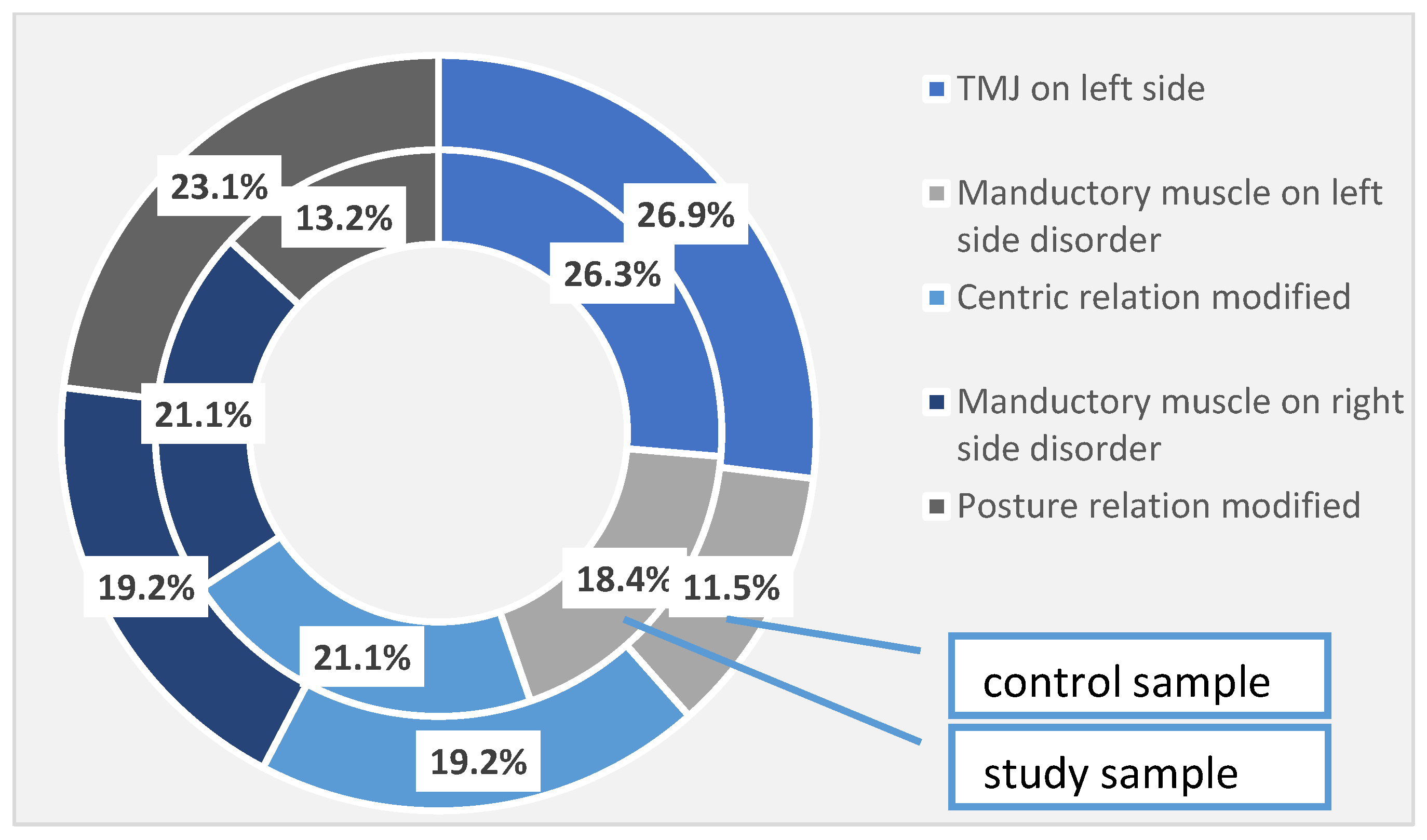
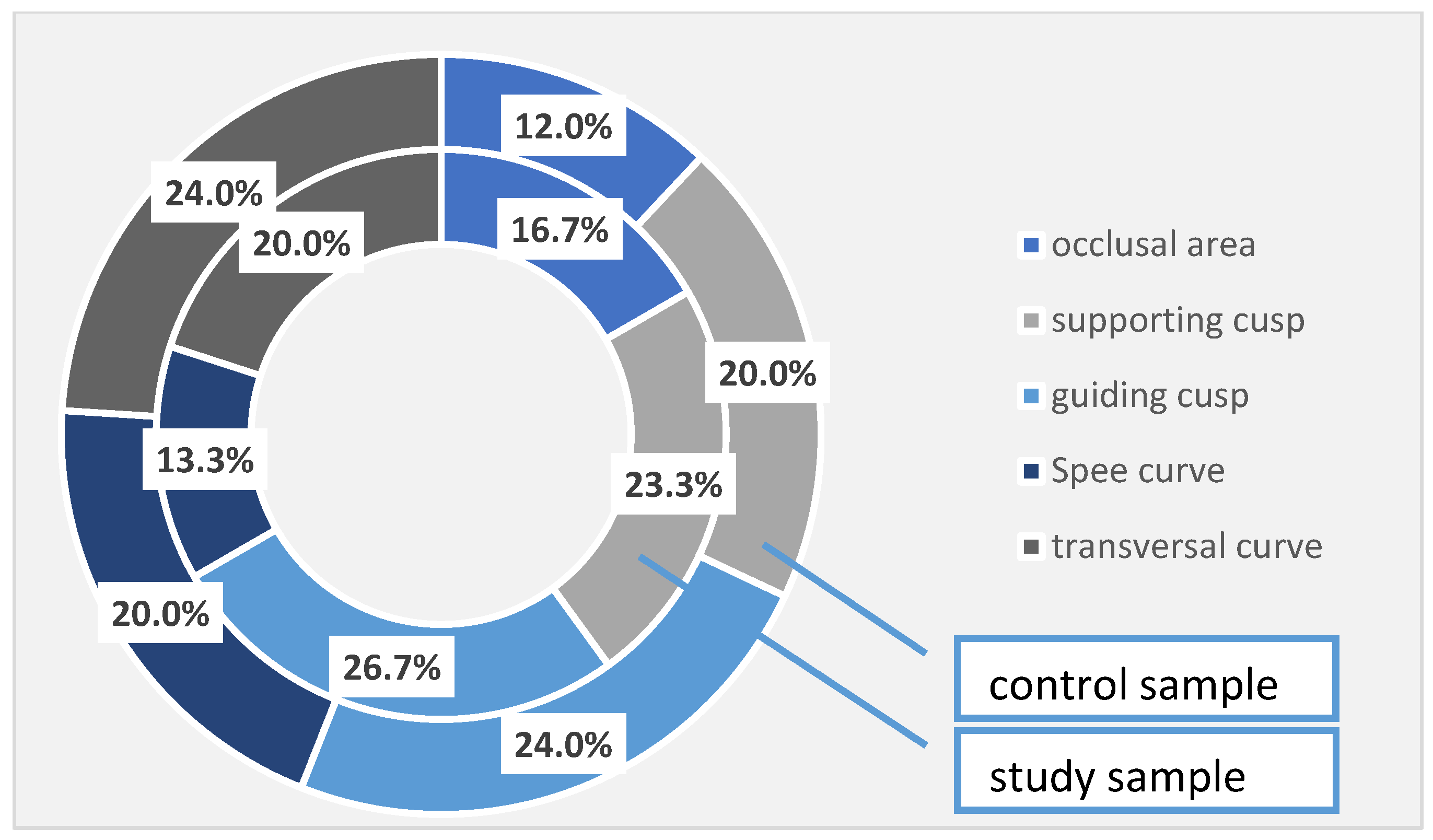

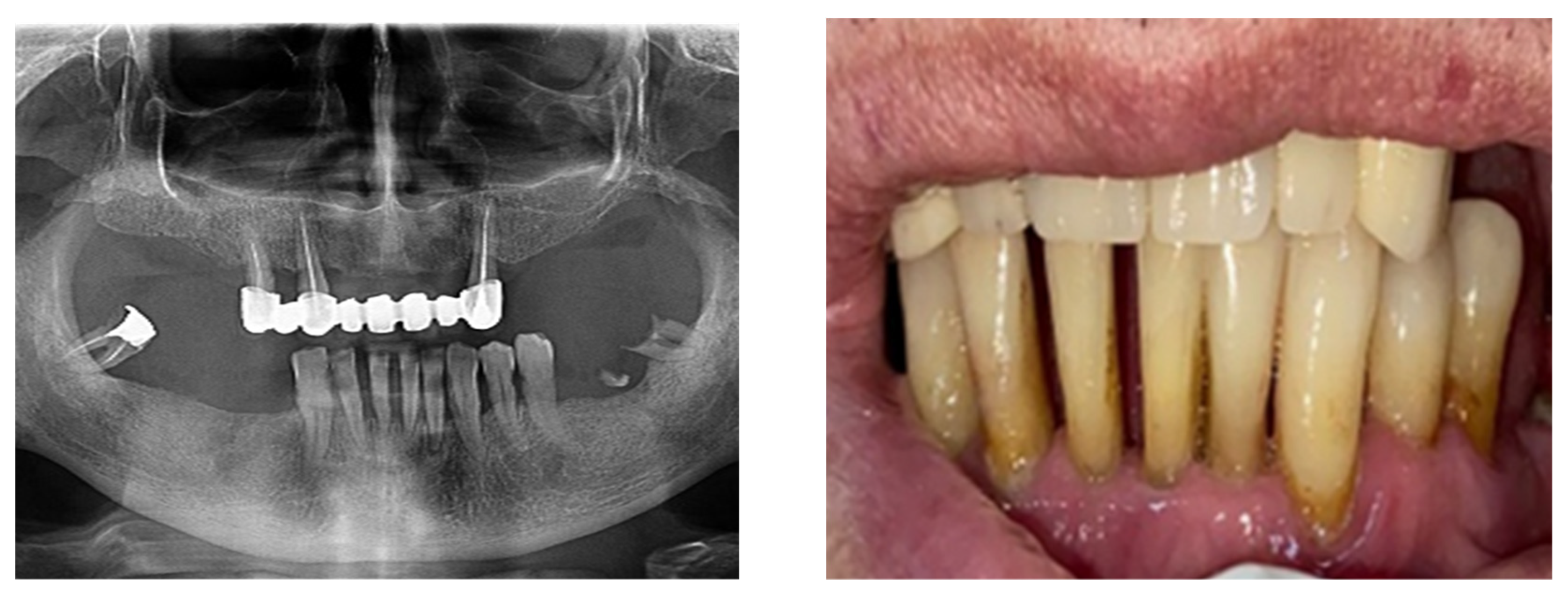

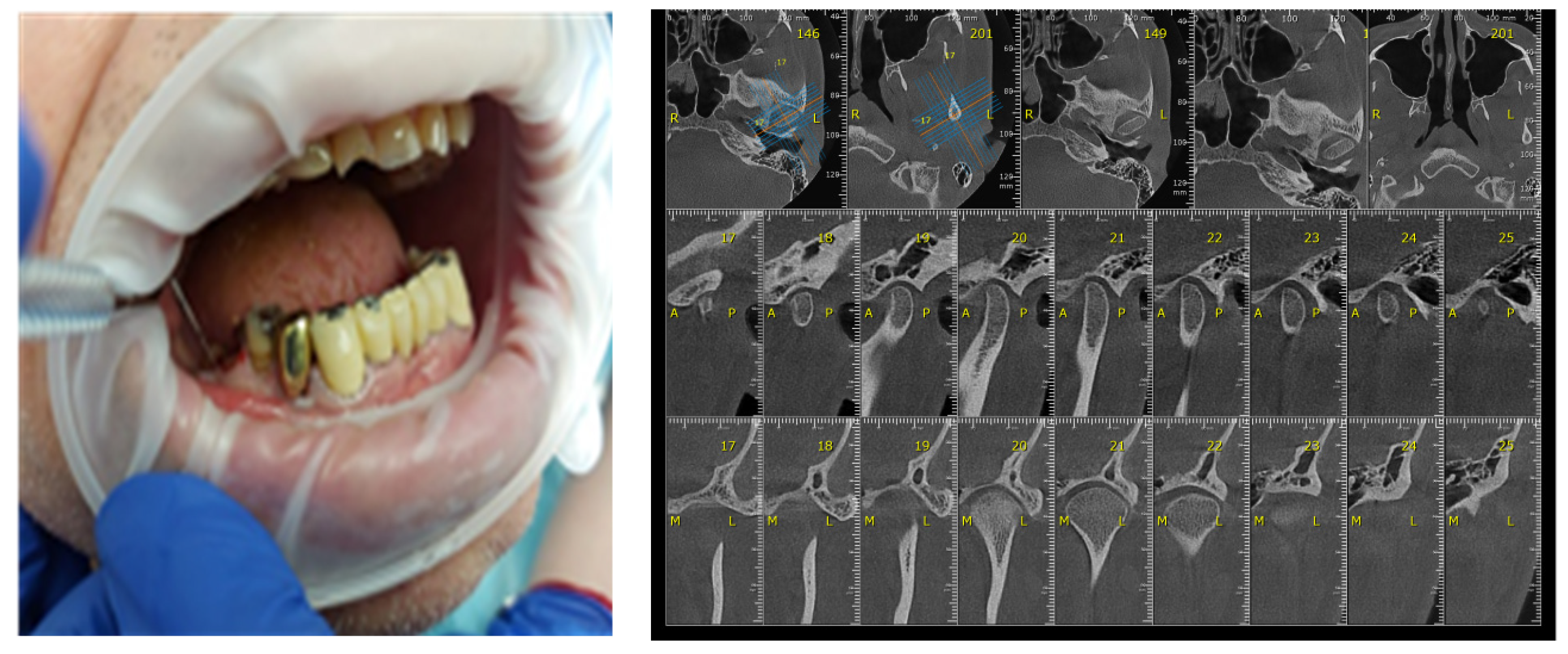
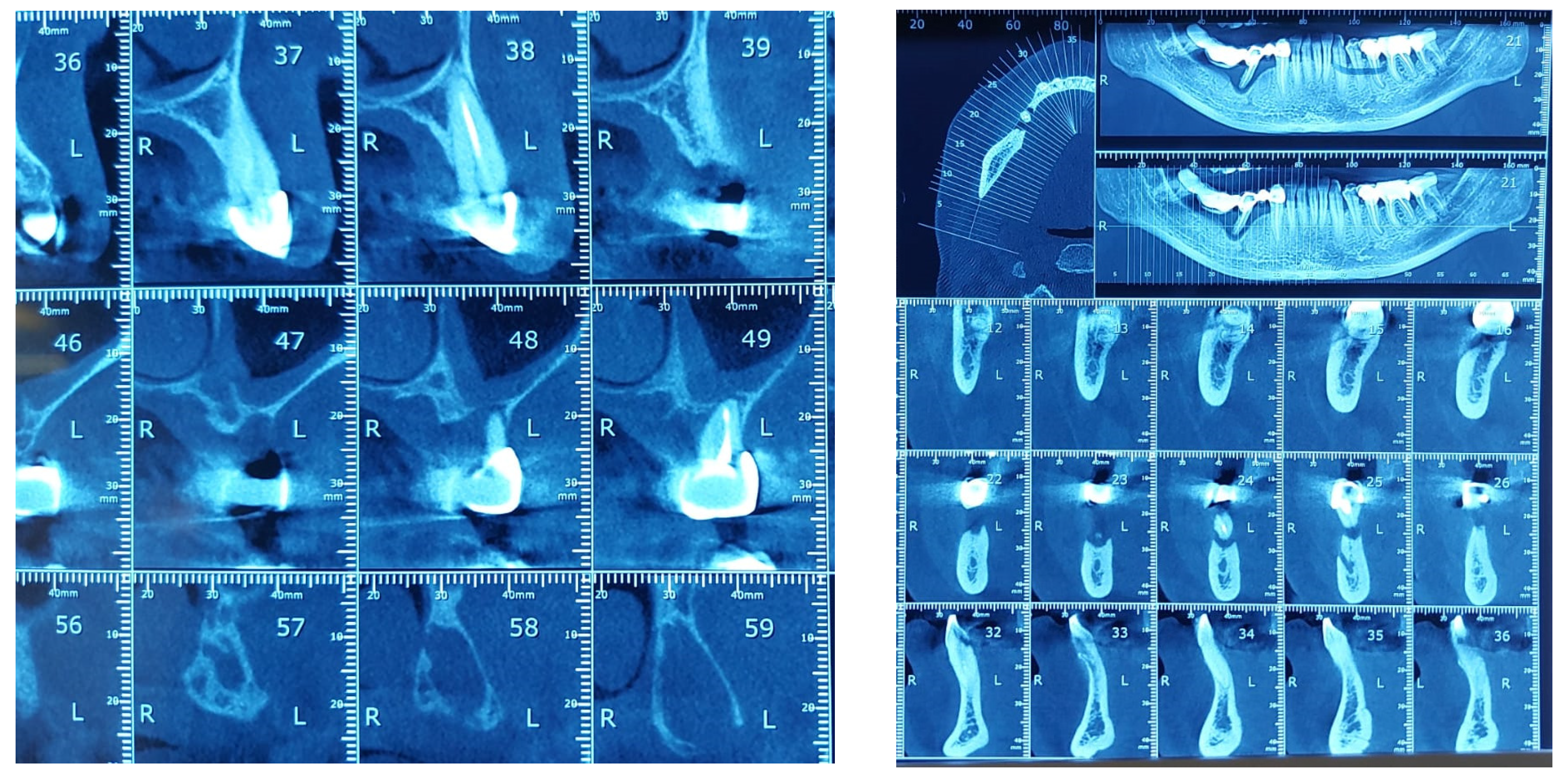
| Parameter | Total (n = 240) | Study Sample (n = 125) | Control Sample (n = 115) | p-Value | |||
|---|---|---|---|---|---|---|---|
| n | % | n | % | n | % | ||
| Gender | 0.940 | ||||||
| M | 130 | 54.2% | 68 | 54.4% | 62 | 53.9% | |
| F | 110 | 45.8% | 57 | 45.6% | 53 | 46.1% | |
| Age group | 0.498 | ||||||
| 20–29 ys | 30 | 12.5% | 16 | 12.8% | 14 | 12.2% | |
| 30–39 ys | 32 | 13.3% | 12 | 9.6% | 20 | 17.4% | |
| 40–49 ys | 52 | 21.7% | 28 | 22.4% | 24 | 20.9% | |
| 50–59 ys | 68 | 28.3% | 36 | 28.8% | 32 | 27.8% | |
| 60–69 ys | 58 | 24.2% | 33 | 26.4% | 25 | 21.7% | |
| Dental mobility | 0.011 *† | ||||||
| absent | 160 | 66.7% | 74 | 59.2% | 86 | 74.8% | |
| present | 80 | 33.3% | 51 | 40.8% | 29 | 25.2% | |
| Gingival recession | 0.007 **† | ||||||
| absent | 148 | 61.7% | 67 | 53.6% | 81 | 70.4% | |
| present | 92 | 38.3% | 58 | 46.4% | 34 | 29.6% | |
| TMJ disorders | 0.173 | ||||||
| absent | 176 | 73.3% | 87 | 69.6% | 89 | 77.4% | |
| present | 64 | 26.7% | 38 | 30.4% | 26 | 22.6% | |
| Occlusal changes | 0.677 | ||||||
| absent | 185 | 77.1% | 95 | 76.0% | 90 | 78.3% | |
| present | 55 | 22.9% | 30 | 24.0% | 25 | 21.7% | |
| a | ||||||||||||
| Dental Mobility | ||||||||||||
| Parameter | Total (n = 240) | Study Sample (n = 125) | Control Sample (n = 115) | |||||||||
| Absent n (%) | Present n (%) | Absent n (%) | Present n (%) | Absent n (%) | Present n (%) | |||||||
| Gender | p = 0.119 † | p = 0.120 † | p = 0.556 † | |||||||||
| M | 81 (62.3%) | 49 (37.7%) | 36 (52.9%) | 32 (47.1%) | 45 (72.6%) | 17 (27.4%) | ||||||
| F | 79 (71.8%) | 31 (28.2%) | 38 (66.7%) | 19 (33.3%) | 41 (77.4%) | 12 (22.6%) | ||||||
| Age group | p = 0.379 † | p = 0.038 *† | p = 0.503 † | |||||||||
| 20–29 ys | 22 (73.3%) | 8 (26.7%) | 10 (62.5%) | 6 (37.5%) | 12 (85.7%) | 2 (14.3%) | ||||||
| 30–39 ys | 17 (53.1%) | 15 (46.9%) | 2 (16.7%) | 10 (83.3%) | 15 (75.0%) | 5 (25.0%) | ||||||
| 40–49 ys | 34 (65.4%) | 18 (34.6%) | 17 (60.7%) | 11 (39.3%) | 17 (70.8%) | 7 (29.2%) | ||||||
| 50–59 ys | 49 (72.1%) | 19 (27.9%) | 23 (63.9%) | 13 (36.1%) | 26 (81.3%) | 6 (18.8%) | ||||||
| 60–69 ys | 38 (65.5%) | 20 (34.5%) | 22 (66.7%) | 11 (33.3%) | 16 (64.0%) | 9 (36.0%) | ||||||
| b | ||||||||||||
| Dental Mobility Degree | ||||||||||||
| Parameter | Total (n = 80) | Study Sample (n = 29) | Control Sample (n = 51) | |||||||||
| I n (%) | II n (%) | III n (%) | I n (%) | II n (%) | III n (%) | I n (%) | II n (%) | III n (%) | ||||
| Gender | p = 0.413 † | p = 0.378 † | p = 0.563 † | |||||||||
| M | 13 (26.5%) | 22 (44.9%) | 14 (28.6%) | 11 (34.4%) | 12 (37.5%) | 9 (28.1%) | 2 (11.8%) | 10 (58.8%) | 5 (29.4%) | |||
| F | 8 (25.8%) | 10 (32.3%) | 13 (41.9%) | 5 (26.3%) | 5 (26.3%) | 9 (47.4%) | 3 (25.0%) | 5 (41.7%) | 4 (33.3%) | |||
| Age group | p = 0.001 **† | p = 0.004 **† | p = 0.257 † | |||||||||
| 20–29 ys | 6 (75.0%) | 2 (25.0%) | - | 5 (83.3%) | 1 (16.7%) | - | 1 (50.0%) | 1 (50.0%) | - | |||
| 30–39 ys | 5 (33.3%) | 7 (46.7%) | 3 (20.0%) | 5 (50.0%) | 3 (30.0%) | 2 (20.0%) | - | 4 (80.0%) | 1 (20.0%) | |||
| 40–49 ys | 8 (44.4%) | 4 (22.2%) | 6 (33.3%) | 5 (45.5%) | 3 (27.3%) | 3 (27.3%) | 3 (42.9%) | 1 (14.3%) | 3 (42.9%) | |||
| 50–59 ys | 1 (5.3%) | 11 (57.9%) | 7 (36.8%) | 1 (7.7%) | 7 (53.8%) | 5 (38.5%) | - | 4 (66.7%) | 2 (33.3%) | |||
| 60–69 ys | 1 (5.0%) | 8 (40.0%) | 11 (55.0%) | - | 3 (27.3%) | 8 (72.7%) | 1 (11.1%) | 5 (55.6%) | 3 (33.3%) | |||
| a | ||||||||||
| Gingival Recession | ||||||||||
| Parameter | Total (n = 240) | Study Sample (n = 125) | Control Sample (n = 115) | |||||||
| Absent n (%) | Present n (%) | Absent n (%) | Present n (%) | Absent n (%) | Present n (%) | |||||
| Gender | p = 0.450 † | p = 0.594 † | p = 0.683 † | |||||||
| M | 83 (63.8%) | 47 (36.2%) | 38 (55.9%) | 30 (44.1%) | 45 (72.6%) | 17 (27.4%) | ||||
| F | 65 (59.1%) | 45 (40.9%) | 29 (50.9%) | 28 (49.1%) | 36 (67.9%) | 17 (32.1%) | ||||
| Age group | p = 0.677 † | p = 0.333 † | p = 0.703 † | |||||||
| 20–29 ys | 20 (66.7%) | 10 (33.3%) | 9 (56.3%) | 7 (43.8%) | 11 (78.6%) | 3 (21.4%) | ||||
| 30–39 ys | 20 (62.5%) | 12 (37.5%) | 4 (33.3%) | 8 (66.7%) | 16 (80.0%) | 4 (20.0%) | ||||
| 40–49 ys | 33 (63.5%) | 19 (36.5%) | 16 (57.1%) | 12 (42.9%) | 17 (70.8%) | 7 (29.2%) | ||||
| 50–59 ys | 44 (64.7%) | 24 (35.3%) | 23 (63.9%) | 13 (36.1%) | 21 (65.6%) | 11 (34.4%) | ||||
| 60–69 ys | 31 (53.4%) | 27 (46.6%) | 15 (45.5%) | 18 (54.5%) | 16 (64.0%) | 9 (36.0%) | ||||
| b | ||||||||||
| Gingival Recession Degree | ||||||||||
| 1 mm n (%) | 2 mm n (%) | 3 mm n (%) | 4 mm n (%) | 5 mm n (%) | ||||||
| Total (n = 92) | ||||||||||
| Gender | p = 0.149 † | |||||||||
| M | 15 (31.9%) | 16 (34.0%) | 4 (8.5%) | 7 (14.9%) | 5 (10.6%) | |||||
| F | 13 (28.9%) | 12 (26.7%) | 13 (28.9%) | 4 (8.9%) | 3 (6.7%) | |||||
| Age group | p = 0.000 **† | |||||||||
| 20–29 ys | 9 (90.0%) | 1 (10.0%) | - | - | - | |||||
| 30–39 ys | 5 (41.7%) | 7 (58.3%) | - | - | - | |||||
| 40–49 ys | 5 (26.3%) | 8 (42.1%) | 5 (26.3%) | 1 (5.3%) | - | |||||
| 50–59 ys | 5 (20.8%) | 7 (29.2%) | 6 (25.0%) | 3 (12.5%) | 3 (12.5%) | |||||
| 60–69 ys | 4 (14.8%) | 5 (18.5%) | 6 (22.2%) | 7 (25.9%) | 5 (18.5%) | |||||
| Study sample (n = 58) | ||||||||||
| Gender | p = 0.285 † | |||||||||
| M | 10 (33.3%) | 10 (33.3%) | 3 (10.0%) | 4 (13.3%) | 3 (10.0%) | |||||
| F | 5 (17.9%) | 8 (28.6%) | 9 (32.1%) | 4 (14.3%) | 2 (7.1%) | |||||
| Age group | p = 0.000 **† | |||||||||
| 20–29 ys | 7 (100.0%) | - | - | - | - | |||||
| 30–39 ys | 3 (37.5%) | 5 (62.5%) | - | - | - | |||||
| 40–49 ys | 2 (16.7%) | 6 (50.0%) | 4 (33.3%) | - | - | |||||
| 50–59 ys | - | 4 (30.8%) | 4 (30.8%) | 3 (23.1%) | 2 (15.4%) | |||||
| 60–69 ys | 3 (16.7%) | 3 (16.7%) | 4 (22.2%) | 5 (27.8%) | 3 (16.7%) | |||||
| Control sample (n = 34) | ||||||||||
| Gender | p = 0.183 † | |||||||||
| M | 5 (29.4%) | 6 (35.3%) | 1 (5.9%) | 3 (17.6%) | 2 (11.8%) | |||||
| F | 8 (47.1%) | 4 (23.5%) | 4 (23.5%) | - | 1 (5.9%) | |||||
| Age group | p = 0.767 † | |||||||||
| 20–29 ys | 2 (66.7%) | 1 (33.3%) | - | - | - | |||||
| 30–39 ys | 2 (50.0%) | 2 (50.0%) | - | - | - | |||||
| 40–49 ys | 3 (42.9%) | 2 (28.6%) | 1 (14.3%) | 1 (14.3%) | - | |||||
| 50–59 ys | 5 (45.5%) | 3 (27.3%) | 2 (18.2%) | - | 1 (9.1%) | |||||
| 60–69 ys | 1 (11.1%) | 2 (22.2%) | 2 (22.2%) | 2 (22.2%) | 2 (22.2%) | |||||
| TMJ Disorders | ||||||
|---|---|---|---|---|---|---|
| Parameter | Total (n = 240) | Study Sample (n = 125) | Control Sample (n = 115) | |||
| Absent n (%) | Present n (%) | Absent n (%) | Present n (%) | Absent n (%) | Present n (%) | |
| Dental mobility | p = 0.000 **† | p = 0.000 **† | p = 0.000 **† | |||
| absent | 139 (86.9%) | 21 (13.1%) | 62 (83.8%) | 12 (16.2%) | 77 (89.5%) | 9 (10.5%) |
| present | 37 (46.3%) | 43 (53.8%) | 25 (49.0%) | 26 (51.0%) | 12 (41.4%) | 17 (58.6%) |
| Gingival recession | p = 0.000 **† | p = 0.001 **† | p = 0.002 **† | |||
| absent | 124 (83.8%) | 24 (16.2%) | 55 (82.1%) | 12 (17.9%) | 69 (85.2%) | 12 (14.8%) |
| present | 52 (56.5%) | 40 (43.5%) | 32 (55.2%) | 26 (44.8%) | 20 (58.8%) | 14 (41.2%) |
| Total (n = 240) | Study Sample (n = 125) | Control Sample (n = 115) | p-Value | ||||
|---|---|---|---|---|---|---|---|
| n | % | n | % | n | % | ||
| TMJ disorder | 0.843 † | ||||||
| TMJ on left side | 17 | 26.6% | 10 | 26.3% | 7 | 26.9% | |
| Manductory muscle on left side disorder | 10 | 15.6% | 7 | 18.4% | 3 | 11.5% | |
| Centric relation modified | 13 | 20.3% | 8 | 21.1% | 5 | 19.2% | |
| Manductory muscle on right side disorder | 13 | 20.3% | 8 | 21.1% | 5 | 19.2% | |
| Posture relation modified | 11 | 17.2% | 5 | 13.2% | 6 | 23.1% | |
| Total | 64 | 100.0% | 38 | 100.0% | 26 | 100.0% | |
| Occlusal Changes | ||||||
|---|---|---|---|---|---|---|
| Parameter | Total (n = 240) | Study Sample (n = 125) | Control Sample (n = 115) | |||
| Absent n (%) | Present n (%) | Absent n (%) | Present n (%) | Absent n (%) | Present n (%) | |
| Dental mobility | p = 0.000 **† | p = 0.000 **† | p = 0.000 **† | |||
| absent | 140 (87.5%) | 20 (12.5%) | 66 (89.2%) | 8 (10.8%) | 74 (86.0%) | 12 (14.0%) |
| present | 45 (56.3%) | 35 (43.8%) | 29 (56.9%) | 22 (43.1%) | 16 (55.2%) | 13 (44.8%) |
| Gingival recession | p = 0.000 **† | p = 0.000 **† | p = 0.005 **† | |||
| absent | 131 (88.5%) | 17 (11.5%) | 62 (92.5%) | 5 (7.5%) | 69 (85.2%) | 12 (14.8%) |
| present | 54 (58.7%) | 38 (41.3%) | 33 (56.9%) | 25 (43.1%) | 21 (61.8%) | 13 (38.2%) |
| Total (n = 240) | Study Sample (n = 125) | Control Sample (n = 115) | p-Value | ||||
|---|---|---|---|---|---|---|---|
| n | % | n | % | n | % | ||
| Occlusal changes | 0.941 † | ||||||
| occlusal area | 8 | 14.5% | 5 | 16.7% | 3 | 12.0% | |
| supporting cusp | 12 | 21.8% | 7 | 23.3% | 5 | 20.0% | |
| guiding cusp | 14 | 25.5% | 8 | 26.7% | 6 | 24.0% | |
| Spee curves | 9 | 16.4% | 4 | 13.3% | 5 | 20.0% | |
| transversal curves | 12 | 21.8% | 6 | 20.0% | 6 | 24.0% | |
| Total | 55 | 100.0% | 30 | 100.0% | 25 | 100.0% | |
| Total (n = 240) | Study Sample (n = 125) | Control Sample (n = 115) | p-Value | ||||
|---|---|---|---|---|---|---|---|
| n | % | n | % | n | % | ||
| Treatment requirements | 0.390 † | ||||||
| craniomandibular repositioning | 27 | 11.3% | 17 | 13.6% | 10 | 8.7% | |
| mouthguard appliance | 29 | 12.1% | 19 | 15.2% | 10 | 8.7% | |
| periodontal etiological treatment | 53 | 22.1% | 21 | 16.8% | 32 | 27.8% | |
| periodontal surgical treatment | 19 | 7.9% | 11 | 8.8% | 8 | 7.0% | |
| odontal treatment | 23 | 9.6% | 11 | 8.8% | 12 | 10.4% | |
| endodontic treatment | 35 | 14.6% | 17 | 13.6% | 18 | 15.7% | |
| fixed front-lateral prostheses | 35 | 14.6% | 17 | 13.6% | 18 | 15.7% | |
| fixed lateral prostheses | 10 | 4.2% | 6 | 4.8% | 4 | 3.5% | |
| unidental prostheses | 9 | 3.8% | 6 | 4.8% | 3 | 2.6% | |
Disclaimer/Publisher’s Note: The statements, opinions and data contained in all publications are solely those of the individual author(s) and contributor(s) and not of MDPI and/or the editor(s). MDPI and/or the editor(s) disclaim responsibility for any injury to people or property resulting from any ideas, methods, instructions or products referred to in the content. |
© 2023 by the authors. Licensee MDPI, Basel, Switzerland. This article is an open access article distributed under the terms and conditions of the Creative Commons Attribution (CC BY) license (https://creativecommons.org/licenses/by/4.0/).
Share and Cite
Checherita, L.E.; Antohe, M.E.; Costin, L.I.; Văscu, M.B.; Stamatin, O.; Croitoru, I.; Solomon, S.M.; Teslaru, S.; Gradinaru, I.; Toma, V.; et al. Research Regarding Dental Mobility Phenomena in the Clinical Recognition Diagnosis of Temporomandibular Disorders. Diagnostics 2023, 13, 598. https://doi.org/10.3390/diagnostics13040598
Checherita LE, Antohe ME, Costin LI, Văscu MB, Stamatin O, Croitoru I, Solomon SM, Teslaru S, Gradinaru I, Toma V, et al. Research Regarding Dental Mobility Phenomena in the Clinical Recognition Diagnosis of Temporomandibular Disorders. Diagnostics. 2023; 13(4):598. https://doi.org/10.3390/diagnostics13040598
Chicago/Turabian StyleChecherita, Laura Elisabeta, Magda Ecaterina Antohe, Lupu Iulian Costin, Mihai Bogdan Văscu, Ovidiu Stamatin, Irina Croitoru, Sorina Mihaela Solomon, Silvia Teslaru, Irina Gradinaru, Vasilica Toma, and et al. 2023. "Research Regarding Dental Mobility Phenomena in the Clinical Recognition Diagnosis of Temporomandibular Disorders" Diagnostics 13, no. 4: 598. https://doi.org/10.3390/diagnostics13040598
APA StyleChecherita, L. E., Antohe, M. E., Costin, L. I., Văscu, M. B., Stamatin, O., Croitoru, I., Solomon, S. M., Teslaru, S., Gradinaru, I., Toma, V., Bogdan, B. P., Cioloca, D. P., Aungurencei, O. D., Balcoș, C. A. M., & Fătu, A. M. (2023). Research Regarding Dental Mobility Phenomena in the Clinical Recognition Diagnosis of Temporomandibular Disorders. Diagnostics, 13(4), 598. https://doi.org/10.3390/diagnostics13040598








